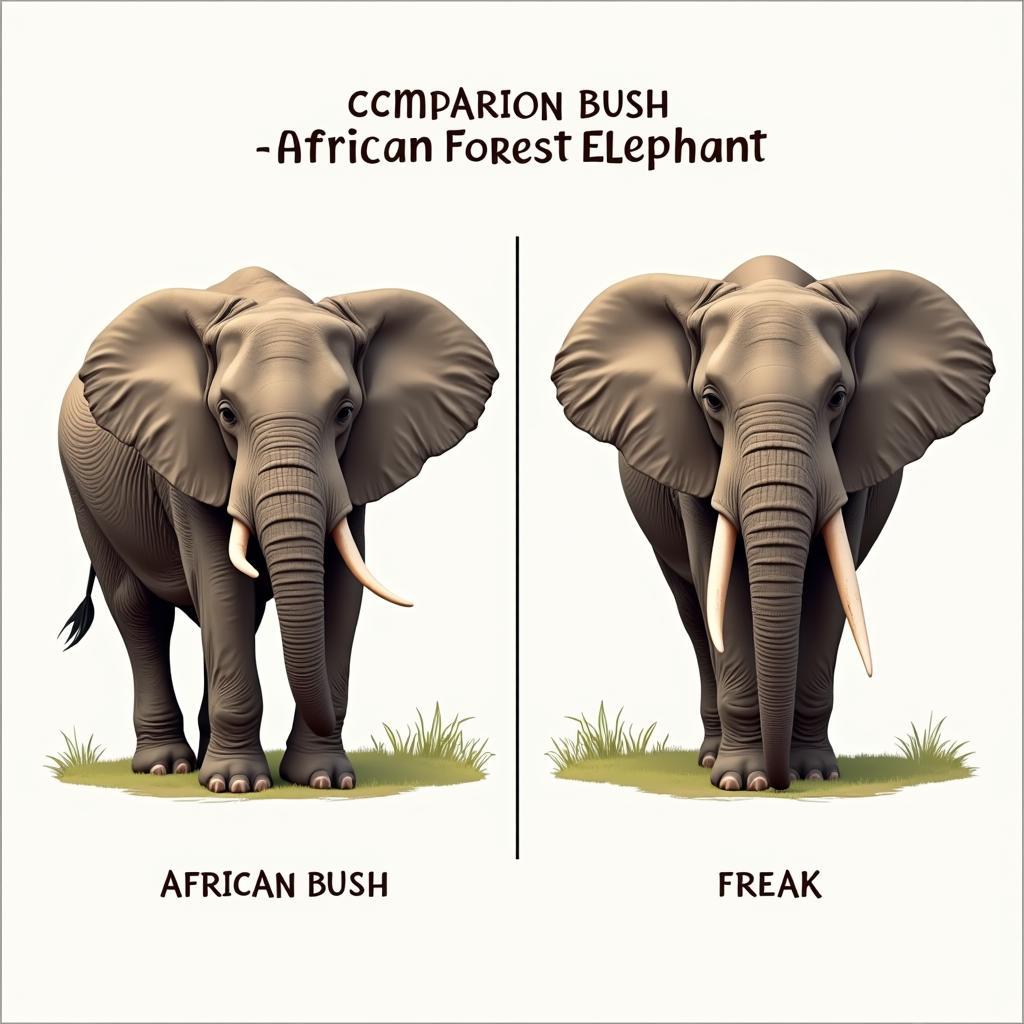African Elephant Taxonomy: Unveiling the Giants’ Family Tree
The African elephant, an iconic symbol of the African savanna, is not just one entity but rather comprises two distinct species: the African bush elephant and the African forest elephant. Understanding African Elephant Taxonomy delves into the fascinating world of these majestic creatures, unraveling their evolutionary history and classifying them within the animal kingdom.
A Deep Dive into African Elephant Classification
Scientists categorize living organisms based on shared characteristics, evolutionary relationships, and genetic makeup. This hierarchical system, known as taxonomy, helps us understand the biodiversity on our planet. So, where do African elephants fit within this grand scheme?
Kingdom to Class: The Broader Picture
Let’s start with the basics:
- Kingdom: Animalia (African elephants are multicellular organisms that obtain nutrition from consuming other organisms).
- Phylum: Chordata (They possess a notochord, a flexible rod-like structure, during some stage of their development).
- Class: Mammalia (They are warm-blooded, have hair, and nourish their young with milk).
Order and Family: Homing in on Elephants
Things get more specific as we move down the taxonomic ladder:
- Order: Proboscidea (This order encompasses elephants and their extinct relatives, characterized by their trunks, tusks, and large size).
- Family: Elephantidae (This family includes both African and Asian elephants, the only surviving members of the Proboscidea order).
 African Elephant Family Group
African Elephant Family Group
Genus and Species: Distinguishing the African Giants
Now, we arrive at the heart of African elephant taxonomy:
- Genus: Loxodonta (This genus distinguishes African elephants from their Asian counterparts in the genus Elephas).
- Species: This is where the classification gets interesting. Until recently, scientists recognized only one species of African elephant: Loxodonta africana. However, genetic studies revealed two distinct lineages, leading to the recognition of two species:
- African bush elephant (Loxodonta africana): Larger, with a concave back and larger ears. They roam the savannas and grasslands of sub-Saharan Africa.
- African forest elephant (Loxodonta cyclotis): Smaller, with straighter tusks and smaller, rounded ears. They inhabit the dense rainforests of Central and West Africa.
 African Bush Elephant vs. African Forest Elephant
African Bush Elephant vs. African Forest Elephant
Why is African Elephant Taxonomy Important?
Understanding that two distinct species of African elephants exist is not merely an academic exercise. This knowledge has profound implications for conservation:
- Tailored Conservation Strategies: Each species faces unique threats and requires specific conservation approaches. For instance, forest elephants are particularly vulnerable to habitat loss due to deforestation.
- Accurate Population Estimates: Recognizing two species allows for more accurate population assessments, crucial for monitoring their status and guiding conservation efforts.
FAQs: Delving Deeper into African Elephant Taxonomy
1. Are African elephants related to mammoths?
Yes, mammoths are extinct members of the order Proboscidea, making them relatives of modern elephants.
2. What are the key differences between African and Asian elephants?
Apart from their geographic distribution, key distinctions include size (African elephants are larger), ear shape (African elephants have larger, fan-shaped ears), and tusk structure (both male and female African elephants have tusks, while only male Asian elephants typically do).
3. Can African bush elephants and African forest elephants interbreed?
While rare, interbreeding between the two species has been documented in areas where their ranges overlap. However, this hybridization raises concerns about the genetic integrity of both species.
4. Are there any subspecies of African elephants?
The taxonomic classification of African elephants is still debated. Some scientists propose subspecies within both the bush and forest elephant categories based on geographic variations, but this remains an area of ongoing research.
5. How can I contribute to African elephant conservation?
Supporting organizations dedicated to elephant conservation, spreading awareness about the plight of these animals, and advocating for responsible tourism practices are just a few ways to make a difference.
Unveiling More Elephant Wonders
Want to learn more about these incredible creatures? Explore further with these related articles:
- African elephant order
- African elephant kingdom classification
- African Indian elephant hybrid
- African elephant under which category
The world of African elephant taxonomy reveals the fascinating complexities of these magnificent animals. As we delve deeper into their family tree, we gain a greater appreciation for their evolutionary history and the importance of protecting them for generations to come.
For any assistance or further information, please contact us at +255768904061, kaka.mag@gmail.com, or visit us at Mbarali DC Mawindi, Kangaga, Tanzania. Our dedicated team is available 24/7 to assist you.

